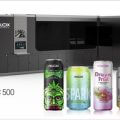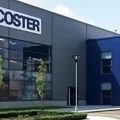The KHS Group presented its KHS/Ferrum SmartCan filling/closing block developed together with the Swiss engineering company Ferrum for the first time at the international drinktec trade fair. Thanks to numerous optimizations in the hygienic design, the compact system surprised with its perfect quality and product safety.
Over the past few years there has been a growing trend to fill beverages in cans for products such as iced tea, vegetable drinks, juices, smoothies, non-alcoholic beers, milkshakes, products close to water or non-alcoholic beers and mixed beer beverages. This development means that the hygiene requirements of beverage fillers are also becoming increasingly stringent – demands that their technology partners are meeting, including system supplier KHS and specialists such as Ferrum. With their SmartCan filling/closing block from KHS/Ferrum, for the first time the two companies have realized a perfect union of their respective machines that features an optimized hygiene concept and together provides more flexibility, higher efficiency and simple operation.
Also, with respect to its successful and popular can fillers, KHS has many new features to offer, especially in the medium and high capacities, which have already proven their worth in its modular filling platforms for PET and glass bottles. Instead of using conventional cams and rollers, the bell guides are now pneumatic, for example. This makes the filling silhouette faster and easier to clean. A similar effect is created by the use of PTFE1 as a sealing material that can be cleaned easily and very effectively. Thanks to PTFE, the hood expansion joints no longer need to be lubricated with water, resulting in improved hygiene and reduced consumption of cleaning media. In addition, the use of PTFE more or less completely rules out flavor transfer from one product to another. This gives beverage producers more flexibility in their production planning.
During the development of the new block, KHS paid special attention to the clean room with elevated jacket plates that is located in the filler scrap body. On the other hand, the housing features a much smaller product room around the filling carousel, enclosing it in a ring like a donut. This reduces the volume of the hygiene zone by approximately 40% and ensures an optimal and targeted flow of sterile air through the sensitive area.
Manfred Härtel, product manager at KHS added, “We don’t use any tight-fitting liners that are difficult to access. Every section of the filler that may require manual intervention during maintenance, overhauls or changeovers can be easily reached.” The objective is to minimize the amount of manual handling to create optimal hygienic conditions. “Today, it is common to work with closed panels where filter fans supply sterile air to the sensitive filling section and protect the open cans from impure store air,” he added.
Finally, wiring hygiene has also been optimized on the new filling platform, Härtel adds. “The power cables leading from each servo drive to the control cabinet have now been enclosed in closed piping. This naturally further improves the excellent hygiene of the entire block,” he reiterated.
A technology that consists of a system of building blocks capable of gliding across any flat body, free of unnecessary structures and with smooth, invisible surfaces. Zubler commented that another advantage is the flexibility of the blockchain system. This is also reflected in the automated equipment with a number of new features, including recipe-specific height adjustment, sewing cam adjustment and a system that facilitates changeovers for parts with different sizes. In addition, all adjustments can be made from the ground, including loading and unloading, which simplifies processes as much as possible and shortens times by up to 30%. Both large doors and low doors allow optimal access with a capacity of up to 108,000 cans per hour.






